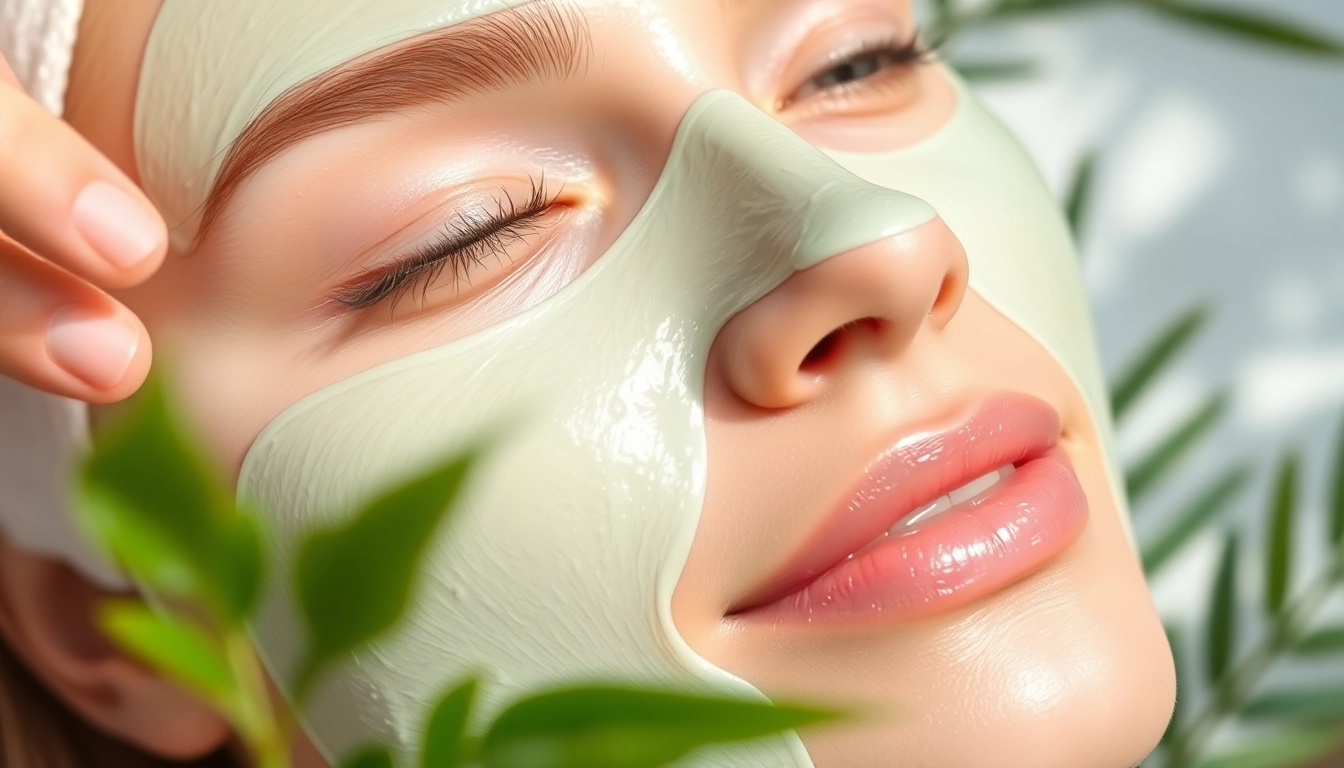Understanding Facial Masks
What is a Facial Mask?
A facial mask is a skincare product that is typically applied to the face and left on for a certain period to improve skin health and appearance. Developed in various forms, facial masks can either come in cream, gel, sheet, or clay forms, offering a range of benefits depending on the ingredients used. These masks are designed to deeply penetrate the skin, providing hydration, detoxification, and nourishment while addressing specific skin issues such as acne, dryness, and aging. Incorporating a facial mask into your skincare regimen can lead to visible improvements, making it an essential component in modern beauty routines.
Benefits of Using a Facial Mask
The benefits of using facial masks are numerous and significant. One of the primary advantages is the targeted treatment they offer. Unlike daily moisturizers or serums, masks can deliver potent ingredients directly to the skin in a concentrated dose, allowing for enhanced efficacy. Here are some detailed benefits:
- Deep Cleansing: Many masks contain clay or charcoal that can draw out impurities and excess oil, leading to a clearer complexion.
- Intense Hydration: Hydrating masks, often infused with ingredients like hyaluronic acid or glycerin, can significantly boost skin moisture levels.
- Anti-Aging Properties: Masks enriched with antioxidants and vitamins can help reduce the appearance of fine lines and wrinkles.
- Calming Effects: Soothing masks with ingredients such as aloe vera and chamomile can reduce redness and irritation.
- Enhanced Skin Texture: Regular use of masks can lead to smoother skin by exfoliating and removing dead skin cells.
Types of Facial Masks
Facial masks can be categorized based on their formulation, texture, and purpose, allowing users to choose what best matches their skin’s needs. Here’s an overview of the most common types:
- Cleansing Masks: Often clay or charcoal-based, these masks draw out impurities, making them ideal for oily or acne-prone skin.
- Hydrating Masks: Typically cream or gel-based, these masks provide a moisture boost to dry or dehydrated skin.
- Exfoliating Masks: Containing enzymes or acids, these masks help remove dead skin cells, improving overall skin texture.
- Sheet Masks: These pre-cut fabric masks are infused with serums, providing an easy, mess-free application that caters to specific skin concerns.
- Overnight Masks: Designed to be worn while sleeping, these masks provide intensive care by sealing in moisture and active ingredients overnight.
Choosing the Right Facial Mask
Identifying Your Skin Type
Before selecting a facial mask, it’s crucial to identify your skin type. Skin can generally be classified into four main categories: normal, oily, dry, and combination. Here’s how to recognize each:
- Normal Skin: Balanced moisture levels without excessive oiliness or dry patches.
- Oily Skin: Shiny appearance with enlarged pores and a tendency for breakouts.
- Dry Skin: Rough texture, tightness, and flaking, often due to lack of moisture.
- Combination Skin: A mix of oily and dry areas, commonly oily in the T-zone and dry on the cheeks.
By understanding your skin type, you can select a mask that will cater to your skin’s specific needs, maximizing effectiveness and minimizing adverse reactions.
Key Ingredients to Look For
Facial masks come with a range of ingredients aimed at addressing specific skin issues. Here’s a breakdown of some key ingredients and their benefits:
- Charcoal: Excellent for detoxifying and absorbing impurities.
- Hyaluronic Acid: A hero for hydration, it can hold up to 1000 times its weight in moisture.
- Vitamin C: Known for its brightening properties, this ingredient can help even out skin tone.
- Aloe Vera: A soothing agent that fights inflammation and hydrates the skin.
- Retinol: An anti-aging powerhouse that promotes cell turnover and can significantly reduce fine lines.
Common Skin Concerns and Solutions
Different skin concerns require tailored solutions. Here are some common skin issues and the types of masks that can effectively address them:
- Acne: Opt for clay or charcoal masks that help absorb oil and draw out impurities.
- Fine Lines and Wrinkles: Look for hydrating masks with retinol or peptides to help promote collagen production.
- Dryness: Cream-based masks packed with hyaluronic acid and essential oils to provide deep moisture.
- Dullness: Exfoliating masks with enzymes or acids can invigorate the skin and promote a glowing complexion.
How to Properly Apply a Facial Mask
Prepping Your Skin
Proper preparation is key to maximizing the benefits of a facial mask. Here are steps to prepare your skin effectively:
- Cleanse: Start with a gentle cleanser to remove makeup, dirt, and impurities.
- Exfoliate: Exfoliating before applying a mask can enhance absorption, as it removes dead skin cells.
- Tone (optional): Using a toner can help restore pH balance and prepare your skin for better product uptake.
Application Techniques
Once your skin is prepped, the application of the mask is the next step. Here are some techniques for effective application:
- Using Fingers: Apply the mask with your fingertips, using gentle circular motions to cover the area evenly.
- Using a Brush: A facial brush provides an even and hygienic application, especially for thicker masks.
- Sheet Masks: Simply unfold and apply to the face, adjusting to fit the contours of your skin.
Timing and Removal Tips
Each mask type may have specific guidelines on how long to leave it on. Generally, here are some tips:
- Follow Instructions: Adhere to the recommended time on the product label for maximum benefits (usually 10 to 20 minutes).
- Don’t Overlap: Avoid leaving masks on longer than directed to prevent skin irritation or dryness.
- Gentle Removal: Use lukewarm water to remove the mask, ensuring all residue is washed away without scrubbing.
DIY Facial Masks: Create Your Own
Top Natural Ingredients
For those who prefer a homemade approach, many natural ingredients can be used to craft effective facial masks. Here are some popular options:
- Honey: Naturally antibacterial and soothing, excellent for dry or acne-prone skin.
- Yogurt: Contains lactic acid, a gentle exfoliant that hydrates and brightens the skin.
- Oatmeal: Great for calming and soothing sensitive skin.
- Avocado: Packed with fatty acids and vitamins, it makes an excellent hydrating mask.
- Cucumber: Refreshing and hydrating, ideal for reducing puffiness and calming the skin.
Step-by-Step Recipes
Here’s how to make a mask using some of the above ingredients:
Honey and Yogurt Mask
Ingredients:
- 1 tablespoon of honey
- 2 tablespoons of plain yogurt
Instructions:
- Mix the ingredients in a bowl until well combined.
- Apply to clean skin, avoiding the eye area.
- Leave on for 15-20 minutes.
- Rinse off with warm water and pat dry.
Avocado and Oatmeal Mask
Ingredients:
- 1 ripe avocado
- 1/2 cup of cooked oatmeal (cooled)
Instructions:
- Mash the avocado in a bowl until smooth, then mix in the cooled oatmeal.
- Apply generously to the face.
- Leave on for 15-30 minutes.
- Rinse off with cool water.
Safety Tips for Homemade Masks
While making your own masks can be fun and rewarding, it’s crucial to follow safety tips to ensure skin health:
- Patch Test: Always perform a patch test to avoid allergic reactions. Apply a small amount to your forearm and wait for 24 hours.
- Use Fresh Ingredients: Ensure that all ingredients are fresh to prevent spoilage and reduce the risk of irritation.
- Avoid Irritating Ingredients: Stay clear of ingredients that may induce sensitivity, such as citrus juices or strong spices.
Maximizing the Benefits of Your Facial Mask
Integrating Masks into Your Skincare Routine
Facial masks can be an effective addition to your skincare routine if used consistently and thoughtfully. It’s beneficial to integrate masks into your routine based on your skin’s needs and the time you can dedicate to self-care. Here’s how:
- Frequency: Use cleansing masks 1-2 times a week and hydrating or soothing masks 2-3 times weekly based on how your skin reacts.
- Timing: Consider using masks in the evening while your skin is relaxed, or after exfoliation for enhanced absorption.
- Layering: You can combine your mask with other treatments, such as serums or moisturizers, but be mindful of not overloading the skin.
Combining Masks with Other Treatments
To enhance the benefits of your facial masks, consider pairing them with other treatments. Here are some combinations that work well:
- Mask + Serum: Apply a serum suited to your skin type before the mask to boost hydration and efficacy.
- Mask + Exfoliation: Following a gentle exfoliation, your skin will better absorb the mask’s ingredients.
- Mask + Moisturizer: After removal, promptly follow up with a good moisturizer to lock in hydration.
Monitoring Results and Adjusting Your Routine
Finally, it’s essential to monitor your skin’s response to masks and adjust your routine accordingly:
- Keep a Journal: Track your skin’s condition, reactions to different masks, and what combinations work best for you.
- Be Patient: Understand that visible results may take time, especially with more intense skin concerns.
- Consult a Professional: If your skin shows signs of irritation or if you’re unsure about what products are right for you, consider seeking advice from a dermatologist.



